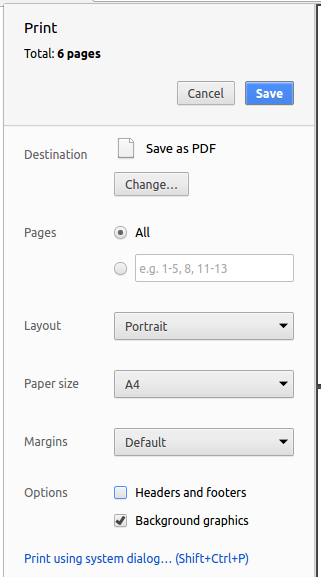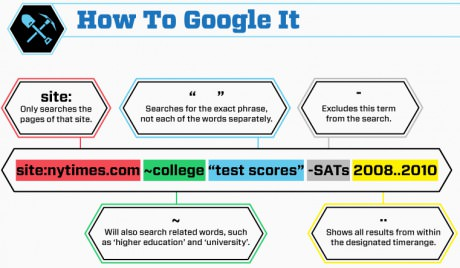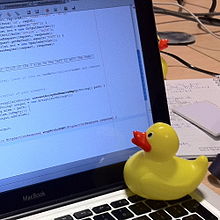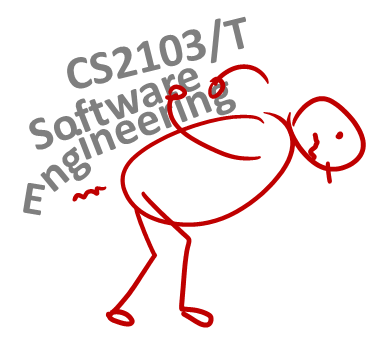Week 1 [Jan 14]
-
Submit the pre-module survey (Compulsory) ⏰
Pre-Module Survey will be available on IVLE Week 1 Monday - Friday 2359 ⏰. We need all of you to submit it because it tells us some important information about you, especially your GitHub username.
-
Week 1 lecture is compulsory
-
See the ' Admin Info' tab (above) for some important admin info you need to know at the start of the semester.
Topics allocated to the week will appear in this tab.
No topics are allocated to week 1 as our lecture falls on the Friday.
Project-related information relevant to the week will appear in this tab.
While you wait for the project to start, brush up your Java knowledge. In particular, learn new features added in Java 8.
Information relevant to the week's tutorial will appear in this tab.
Note: We use Tutorial 5 to mean the tutorial in week 5.
There is no tutorial in week 1, but there is a tutorial in week 2.
Admin info relevant to the week's will appear in this tab.
The Schedule page is your main source of information for CS2103/T. You will need to refer to it weekly.
More details for the upcoming weeks will be added as the weeks progress. In general, information given for more than 1 week into the future should be treated as tentative.
Browser Compatibility
Most of this will work on most mainstream Browsers, but embedded slides are best viewed using Chrome.
Information Layers
This book tries to layer information so that readers can decide to omit less important layers if they wish to.
More important information are in bold or highlighted while less important information are dimmed or in collapsed panels such as the below.
Less important info
Less important info
Less important info
Tabs indicate alternative formats of the same content (e.g. video vs text). You can choose the one you like and ignore the other tabs.
Video describing X
Dotted underlines indicate
This website uses a star rating system to indicate the priority level of contents.
Relevant: [
Star rating system
Start with things that are rated one-star and progress to things with more stars. Things rated four stars are optional.
Star ratings for Learning Outcomes (and textbook sections):
-
One-star topics : The topics you need to learn just to keep up with the module. We recommend you to learn these topics if you want to pass the module (i.e. up to a C grade).
-
Two-stars topics : Can get you up to a B+.
-
Three-stars topics : Can get you up to an A.
-
Four-stars topics : Can be useful for getting an A+, tutors positions, and getting into downstream SE modules that have competitive entry requirements (e.g., CS3281&2, CS3217, CS3216). Four-star topics are not examinable. Omitting them will not affect your CAP (as A+ has the same CAP as an A grade)
-
Topics marked with two icons e.g., : , : , : , : are relevant topics you are expected have learned in prerequisite modules. They are given for reference, but are examinable. The number of stars indicate the progression of topics, similar to the star rating system above i.e., one-star prerequisite topics are the most basic and the most important. four-star pre-requisite topics can be ignored without affecting CAP.
Star ratings for other things e.g., admin info sections:
- The module uses a similar star rating system to indicate the importance of other info in this website. i.e., information rated as one-star are the most essential. Info rated four stars are non-essential and can be ignored without affecting your ability to follow the module.
Conventions Used
Shorthand Headings
Meaning of some shortened headings:
-
What : the meaning of the concept in concern
-
Why : the motivation behind the concept in concern
-
How : the usage of the concept in concern
-
When : the pros and cons of the concept in concern, when to use the concept
Boxed-Text Styles
Meaning of Icons
tangential : tangential info, can be ignored if not interested
: direct link to the LO. Ctrl+Click to open the LO in new window/tab.
: learning outcomes
: prerequisite learning outcome
: examples
: resources
: exercises
: printable version
: preview/more info
: video
: textual description
: slides
: output produced by running code
question without answer
question with answer
: tasks to do
: lecture
: tutorial
: evidence you can use to prove you have achieved a learning outcome
⏰ : deadline
Searching for keywords
Use the search box in the top navigation bar to search for keywords in the website pages. If you cannot find the content related to a keyword, let us know by posting in the forum so that we can add the missing keyword to our search index.
Saving as PDF Files
-
Use Chrome to load the page you want to save as pdf.
-
Click on the
Printoption in Chrome’s menu. -
Set the destination to
Save as PDF, then clickSaveto save a copy of the file in PDF format. For best results, use the settings indicated in the screenshot below.

Printing Textbook Content
Printer-friendly version (indicated by icon) have been provided for each chapter and the whole book. You can use them for saving as pdf files or printing.
Making this Website Better
This website was generated using the MarkBind software developed at NUS. We welcome bug reports, suggestions, and contributions, to be submitted at the website issue tracker.
[Friday (previous week)]
Attend the lecture for,
- a recap of the preceding week's topics
- an introduction to the current week's topics
Relevant: [

Timing/venue:
| Semester | Venue | Time |
|---|---|---|
| Semester 1 (Aug-Nov) | ICube Auditorium | 1600-1800 |
| Semester 2 (Jan-April) | ICube Auditorium | 1400-1600 |
Lectures start on time sharp and end around 15 minutes before official end time.
CS2103T lectures are same as that for CS2103.
Attendance: Attendance for the first lecture is compulsory.
Webcast: All lectures will be webcast. However, some things are not captured well in the webcast recording. You are advised to treat the webcast as a 'backup' for you to catch up anything missed during the lecture. Webcast lectures will be available on LumiNUS.
Handouts: There are no handouts. All learning materials are organized around topics, are given in Web format, and can be found in the Textbook section and are also embedded in from the Schedule page.
Slides: Our lecture slides are not suited for printing or using as a reference during the lecture/exams. They are only an aid for lecture delivery. Slides will be uploaded to LumiNUS after the lecture.
[Saturday (previous week) - Tuesday]
- Use the relevant learning resources to learn the topics.
- Self-test your knowledge using exercises given in the learning resources.
- If you don't have time to learn all topics assigned to the week, use the star rating system to decide which ones to do first.
[Wednesday - Friday]
Attend the tutorial to,
- demonstrate evidence of your learning weekly topics to the tutor
- learn from peer demos of showing evidence of their own learning
Relevant: [
Our tutorials start on week 2 (even before CORS tutorial bidding is over), not in week 3 as other modules do. CS2103 (not CS2103T) students need to choose a temporary tutorial slot for week 2 tutorial. We'll inform you the procedure to do so in due course.
Our tutorial IDs are different from CORS. Format: W09 means Wednesday 0900 and so on.
| Module | Tutorial ID (ID in CORS) | Time | Venue | Tutors (contact details) |
|---|---|---|---|---|
| CS2103T | W09 (T01) | Wed 0900 | COM1-B103 (ALL)* | Akshay, Marlene |
| CS2103T | W10 (T02) | Wed 1000 | COM1-B103 (ALL) | Yuan Chuan, Yan Bin |
| CS2103T | W11 (T03) | Wed 1100 | COM1-0210 (SR10) | Yuan Chuan, Yash |
| CS2103 | W12 (01) | Wed 1200 | COM1-0210 (SR10) | Cancelled |
| CS2103 | W13 (02) | Wed 1300 | COM1-0210 (SR10) | Ewald, Triston |
| CS2103T | W14 (T04) | Wed 1400 | COM1-0210 (SR10) | Yuan Chuan, Jeffry |
| CS2103 | W15 (03) | Wed 1500 | COM1-0210 (SR10) | Yan Hwa, Melodies |
| CS2103 | W16 (04) | Wed 1600 | COM1-B103 (ALL) | Rong Hua, Lester |
| CS2103T | W17 (T05) | Wed 1700 | COM1-B103 (ALL) | Yong Soon, Sharan |
| CS2103T | T10 (T07) | Thu 1000 | COM1-0210 (SR10) | Cancelled |
| CS2103T | T12 (T06) | Thu 1200 | COM1-0210 (SR10) | Quoc Bao, Hung Siang |
| CS2103T | F08 (T08) | Fri 0800 | COM1-0210 (SR10) | Cancelled |
| CS2103 | F09 (05) | Fri 0900 | COM1-0210 (SR10) | Cancelled |
*ALL: Active Learning Room
What happens during the tutorial:
- A tutorial group is handled by two tutors. Each tutor will work with two teams.
- The tutor will direct students to share/discuss evidence of learning the weekly topics.
- If some students have met with difficulties while learning a topic, the tutor can direct those students to get help from those who have learned the topic. The number of topics that can be covered in the tutorial session depends on how well-prepared you are.
- The tutor will observe, and give feedback on how well you are learning required topics.
- Please bring your laptop to tutorials. You often need it to show evidence of learning the topics. At other times, we ask you to work on project related things with your team members, which too may require the laptop.
Relevant: [
What if I don’t carry around a laptop?
If you do not have a laptop or prefer not to bring the laptop, it is up to you to show your work to the tutor in some way (e.g. by connecting to your home PC remotely), without requiring extra time/effort from the tutor or team members.
Reason: As you enjoy the benefits of not bring the laptop; you (not others) should bear the cost too.
The role of our tutors is different from tutors in other modules.
- No direct tech help: Tutors are prohibited from giving direct technical help. Rationale: We want you to learn the vital survival skill of troubleshooting technical problems.
Relevant: [
This guide is mostly about getting tech help, but it also applies to getting clarifications on module topics too. e.g. what is the difference between refactoring and rewriting?

We want to move you away from 'hand holding' and make you learn how to solve problems on your own. This is a vital survival skill in the industry and it needs practice.
Whether it is a technical problem (e.g. error when using the IDE) or a doubt about a concept (e.g. what is the difference between scripted testing and exploratory testing?) the teaching team is happy to work with you when you look for a solution/answer, but we do not do it for you. We discourage unconditional direct help from tutors because we want you to learn to help yourself. Yes, we believe in ‘tough love’😝.
The question you should always ask yourself is, 'how do I solve this problem if the lecturer/tutors are not around to help me?'

What not to do:
- When faced with a technical problem or a doubt about a concept, don't fire off an email lecturer/tutor immediately, unless it is something only the lecturer/tutor is supposed to know.
What to do:
-
Check what is given: Check if the problem/concept has been discussed in the lectures, textbook, or the list of resources given to you. Yes, it is easier for you to write an email to the tutor/lecturer instead, but that shouldn't be your default behavior. We know that sometimes it is difficult to find stuff in the resources we have provided. But you should try first.
-
Search: It is very likely the answer already exists somewhere in the cyberspace. Almost every programming-related question has been answered in places like stackoverflow. Don't give an opportunity for someone to ask you to STFW.
Pay attention to the error message you encounter. Sometimes it also contains hints as to how to fix the problem. Even if not, a web search on the error message is a good starting point.

-
Ask peers:
Ask your team members.
Ask classmates using the module forum (or the slack channel). Even if you figured out one way to solve a problem, discussing it on a public forum might lead you to better ways of solving it, and will help other classmates who are facing similar problems too. If you are really shy to ask questions in the forum, you may use this form to submit your question anonymously which we will then post in the forum.

Rubber duck debugging is an informal term used in software engineering to refer to a method of debugging code. The name is a reference to a story in the book The Pragmatic Programmer in which a programmer would carry around a rubber duck and debug his code by forcing himself to explain it, line-by-line, to the duck.
[for more, see wikipedia entry]
-
Ask the world using programming forums such as stackoverflow.
Here are some tips for posting help request:
-
PLEASE search for existing answers before you post your question in those public forums; You don't want to appear as a 'clueless' or 'too lazy to do your research' person in a public forum.
-
Learn to isolate the problem. "My code doesn't work" isn't going to help even if you post the whole code online. Others don't have time to go through all of your code. Isolate the part that doesn't work and strip it down to the bare minimum that is enough reproduce the error. Sometimes, this process actually helps you to figure out the problem yourself. If not, at least it increases the chance of someone else being able to help you.
💡 How to isolate problematic code? Delete code (one bit at a time) that is confirmed as not related to the problem. Do that until you can still reproduce the problem with the least amount of code remaining.
-
Generalize the problem. "How to write tasks to a text file using Java" is too specific to what you are working on. You are more likely to find help if you post a thread called (or search for) "How to write to a file using Java".
-
Explain well. Conversations via online forums take time. If you post everything that is relevant to your problem, your chances of getting an answer in the first try is higher. If others have to ask you more questions before they can help you, it will take longer. But this doesn't mean you dump too much information into the thread either.
💡 Know what these stand for: RTFM, STFW, GIYF
-
- Raise your question during a tutorial. Some questions can be discussed with the tutor and tutorial-mates.
What kind of questions are suitable to discuss with the tutor? Consider these two questions you might want to ask a tutor:
- Good This is how I understood/applied coupling. Is that correct? - Such questions are welcome. Reason:This question shows you have put in some effort to learn the topic and seeking further clarification from the tutor.
- Bad What is coupling? - Such questions are discouraged. Reason: This question implies you haven’t done what you could to learn the topic in concern.
-
Talk to the lecturer before or after the lecture. The lecturer will be at the lecture venue from 30 minutes before the start of the lecture.
-
Request our help: Failing all above, you can always request for help by emailing the lecturer.
Resources
- [lifehacker article] Google Tips and Tricks Every Student Should Know
- [Article] How To Ask Questions The Smart Way by Eric Steven Raymond
- No ‘teaching’: Tutors are prohibited from “teaching” concepts that are covered in lectures or other learning resources given to you. Self-learning is a vital part of the module. But of course tutors can help you clarify doubts under the right circumstances.
Relevant: [
- Raise your question during a tutorial. Some questions can be discussed with the tutor and tutorial-mates.
What kind of questions are suitable to discuss with the tutor? Consider these two questions you might want to ask a tutor:
- Good This is how I understood/applied coupling. Is that correct? - Such questions are welcome. Reason:This question shows you have put in some effort to learn the topic and seeking further clarification from the tutor.
- Bad What is coupling? - Such questions are discouraged. Reason: This question implies you haven’t done what you could to learn the topic in concern.
- No leading from the front: Tutors are not expected to lead your project effort. They will not tell you how to do project tasks or when to do project tasks. You have to figure those out yourselves. But tutors will give you feedback on how you are doing (or have done) project tasks so that you can improve further.
Timing/venue:
- Please refer to the Schedule page for further details on each tutorial.
- You are expected to arrive on time. Punctuality is considered for participation marks.
- You may leave the class 15 minutes before the hour if you have another class right after. There is no need to wait till the tutor dismisses you. However, inform the tutor (as a courtesy) before leaving if you leave before the class is dismissed.
- Please make sure you vacate the table 5 minutes before the hour so that the next group can start on time.
- In the past many students have suggested to increase the tutorial duration because 1 hour is barely enough to get through all weekly topics. Increasing the tutorial time is not possible due to lack of venues and tutors. Instead, let's try to make the best of the one hour available by coming well prepared and starting on time.
Grading:
Tutorials are not graded. However, your conduct will be reviewed by team members and the tutor which will determine your participation marks.
[Exchange students only] Registering for tutorials:
- Exchange students need to use the ORATUT system to register for the tutorials. You must have received the instructions from UG office on how/when to go about the registration process. If not, please talk to UG office. When we can see your appeal on ORATUT, we can allocate you to the tutorial slot.
A balanced, iterative, and brown-field introduction to Software Engineering...

CS2103/T is an introductory Software Engineering module. It covers roughly a 50-50 balance of basic SE theory and practice that a student needs to know before going for SE internships in the industry or taking
On the theory side, this module is supported by a customized online textbook Software Engineering for Self-Directed Learners, integrated into this module website.
The practice side of this module is mainly covered by a team project. Students are expected to take over an existing project AddressBook-Level4 (AB4) -- a relatively small yet non-trivial (10 KLoC) generic product -- and enhance it into a better product or evolve it into a different product. To help students tackle the learning curve of working with 10 KLoC of code, the module takes them through a series of projects of increasing size, from AddressBook-Level1(1 KLoC) to AddressBook-Level3(4 KLoC).
Given below is a summary of what the module covers and does not cover.
| Topic | Covered | Not covered |
|---|---|---|
| Java | Used heavily, but not taught | syntax (reason: expected prerequisite knowledge) |
| OOP | Used in a non-trivial project, |
basics (reason: expected prerequisite knowledge) |
| SE tools/practices |
|
those specific to start-ups |
| Modeling |
|
intensive |
| Requirements |
|
rapid prototyping, heavy UI design, designing a product from scratch |
| Documentation | Documentation targeting end users (example) as well as those targeting developers (example) | Marketing materials |
| Project Management | Iterative delivery of a product, working collaboratively with team members, on-site as well as remotely | Setting up project infrastructure from scratch |
| Testing |
|
|
| Applications domains | Cross-platform desktop applications | Web programming, Mobile programming, Database programming |
Where is everything?
The Schedule page presents all you need to know in chronological order while the other pages have some of the same content organized by topic.
The Schedule page is the one page you need to refer weekly. Although there is a lot of content in the Admin Info page and the Textbook page -- which you are welcome to read in those respective pages -- the same content is also embedded in the relevant weeks of the Schedule page. Embedded extracts usually appear in expandable panels and can be identified by the symbol in the panel title.
Prior Knowledge: Java and OOP
This module requires you to write Java code almost every week, starting from the very first week. If your Java skills are rusty, do brush up your Java programming skills.
In particular, you may want to have a look at the new Java 8 features such as streams, lambdas, Optionals, that may not have been covered in previous Java modules.
CS2103 students: This module assumes a reasonable prior knowledge of Java and OOP because most students taking this module have taken two Java modules before. If you are totally new to Java, you may be better off switching to CS2113 (Software Engineering & Object-Oriented Programming) instead.
Workload
Given 60% of this module is based on CA, it can appear to be heavy. However, it is not expected that you will spend more time on this module than its peer modules (e.g., if this module is core for you, it should not take more time than other level 2 core modules in your program).
- Note that the module contains more things than a typical students can do, in order to provide enough things for even the strongest students to learn as much as they wish to.
- This means it is perfectly OK if you don't have time to learn everything the module offers. Control your workload based on time you spend for the module in a week e.g., 1-1.5 days per week.
- We have provided a star rating system to guide you when prioritizing which things to do.
Star rating system
Start with things that are rated one-star and progress to things with more stars. Things rated four stars are optional.
Star ratings for Learning Outcomes (and textbook sections):
-
One-star topics : The topics you need to learn just to keep up with the module. We recommend you to learn these topics if you want to pass the module (i.e. up to a C grade).
-
Two-stars topics : Can get you up to a B+.
-
Three-stars topics : Can get you up to an A.
-
Four-stars topics : Can be useful for getting an A+, tutors positions, and getting into downstream SE modules that have competitive entry requirements (e.g., CS3281&2, CS3217, CS3216). Four-star topics are not examinable. Omitting them will not affect your CAP (as A+ has the same CAP as an A grade)
-
Topics marked with two icons e.g., : , : , : , : are relevant topics you are expected have learned in prerequisite modules. They are given for reference, but are examinable. The number of stars indicate the progression of topics, similar to the star rating system above i.e., one-star prerequisite topics are the most basic and the most important. four-star pre-requisite topics can be ignored without affecting CAP.
Star ratings for other things e.g., admin info sections:
- The module uses a similar star rating system to indicate the importance of other info in this website. i.e., information rated as one-star are the most essential. Info rated four stars are non-essential and can be ignored without affecting your ability to follow the module.
Create a personal GitHub account if you don't have one yet.
-
You are advised to choose a sensible GitHub username as you are likely to use it for years to come in professional contexts.
-
Strongly recommended: Complete your GitHub profile. In particular,
- Specify your full name.
- Upload a profile photo that matches
our requirements .
The GitHub profile is useful for the tutors and classmates to identify you. If you are reluctant to share your info in your long-term GitHub account, you can remove those details after the module is over or create a separate GitHub account just for the module.
-
You are discouraged from changing your GitHub username during the semester/exam/grading period as it can cause our auto-grading scripts to miss your GitHub activities. If you do change your GitHub username during that period, please let us know immediately.
-
The purpose of the profile photo is for the teaching team to identify you. Therefore, you should choose a recent individual photo showing your face clearly (i.e., not too small) -- somewhat similar to a passport photo. Some examples can be seen in the 'Teaching team' page. Given below are some examples of good and bad profile photos.

-
If you are uncomfortable posting your photo due to security reasons, you can post a lower resolution image so that it is hard for someone to misuse that image for fraudulent purposes. If you are concerned about privacy, you can request permission to omit your photo from the page by writing to prof.
Communication: Keeping a record of communications among your team can help you, and us, in many ways. We encourage you to do at least some of the project communication in written medium (e.g., GitHub Issue Tracker) to practice how to communicate technical things in written form.
- Instead of the LumiNUS forum, we encourage you to post your questions/suggestions in this github/nus-cs2103-AY1819S2/forum.
- Alternatively, you can post in our slack channel https://nus-cs2103-ay1819s2.slack.com. We encourage you all to join the slack channel (you'll need to use an email address ending in
@nus.edu.sg,@comp.nus.edu.sg,@u.nus.edu.sgor@u.nus.eduto join this channel). - Note that slack is useful for quick chats while issue tracker is useful for longer-running conversations. GitHub forum posts will not appear in slack (or vice-versa).
- Later on, you may create a channel for your own team in slack.

[Picture: The team that was at the top of early Google]
When to form teams: Your team will be formed in week 3 tutorial.
Team size: The default team size is five.
Team ID: This will be given to you after forming teams. It has the form TUTORIAL_ID-TEAM_NUMBER e.g, W14-2 means you are in tutorial W14 (i.e., Wed 1400-1500), team 2.
Relevant: [
Our tutorials start on week 2 (even before CORS tutorial bidding is over), not in week 3 as other modules do. CS2103 (not CS2103T) students need to choose a temporary tutorial slot for week 2 tutorial. We'll inform you the procedure to do so in due course.
Our tutorial IDs are different from CORS. Format: W09 means Wednesday 0900 and so on.
| Module | Tutorial ID (ID in CORS) | Time | Venue | Tutors (contact details) |
|---|---|---|---|---|
| CS2103T | W09 (T01) | Wed 0900 | COM1-B103 (ALL)* | Akshay, Marlene |
| CS2103T | W10 (T02) | Wed 1000 | COM1-B103 (ALL) | Yuan Chuan, Yan Bin |
| CS2103T | W11 (T03) | Wed 1100 | COM1-0210 (SR10) | Yuan Chuan, Yash |
| CS2103 | W12 (01) | Wed 1200 | COM1-0210 (SR10) | Cancelled |
| CS2103 | W13 (02) | Wed 1300 | COM1-0210 (SR10) | Ewald, Triston |
| CS2103T | W14 (T04) | Wed 1400 | COM1-0210 (SR10) | Yuan Chuan, Jeffry |
| CS2103 | W15 (03) | Wed 1500 | COM1-0210 (SR10) | Yan Hwa, Melodies |
| CS2103 | W16 (04) | Wed 1600 | COM1-B103 (ALL) | Rong Hua, Lester |
| CS2103T | W17 (T05) | Wed 1700 | COM1-B103 (ALL) | Yong Soon, Sharan |
| CS2103T | T10 (T07) | Thu 1000 | COM1-0210 (SR10) | Cancelled |
| CS2103T | T12 (T06) | Thu 1200 | COM1-0210 (SR10) | Quoc Bao, Hung Siang |
| CS2103T | F08 (T08) | Fri 0800 | COM1-0210 (SR10) | Cancelled |
| CS2103 | F09 (05) | Fri 0900 | COM1-0210 (SR10) | Cancelled |
*ALL: Active Learning Room
Team composition
We allow some freedom in choosing team members, subject to these constraints:
-
All team members should be in the same tutorial. Delay forming teams until your place in a tutorial is confirmed. We do not allow changing tutorials to team up with your preferred team mates.
-
Teams of single nationality are not allowed unless the only language common among all team members is English. e.g. an all-Singaporean team that include both Chinese and Malay students. Rationale: to train you to work in multicultural teams, to ensure that English is used for all project communication
-
No more than one exchange students per team Rationale: to increase interaction between exchange students and NUS students.
-
Same gender teams are highly discouraged unless unavoidable. Rationale: to train you for mixed-gender work environments.
-
Also note that we may modify teams when circumstances call for it. There is no avenue for you to object. Staying with your preferred team is not guaranteed.
 |
The main language used in this module is Java. You should use Java for all programming activities, the project, and exam answers. The module doesn’t “teach” Java. We assume you already know Java basics. We expect you to learn on your own any Java constructs not covered in your previous modules. |
Java coding standard
This module follows the OSS-NUS Java coding standard.
In the project you are required to follow basic and intermediate guidelines (those marked as ⭐️ and ⭐️⭐️). In other programming activities in the module, we recommend (but not require) you to follow the coding standard.
This module is supported by a customized online textbook Software Engineering for Self-Directed Learners (CS2103 edition), integrated into this module website. While it is in a dynamic Web page format, there is a way to save the main text as pdf files. Printer-friendly versions have been provided too.
Relevant: [
[Exchange students only] Registering for tutorials:
- Exchange students need to use the ORATUT system to register for the tutorials. You must have received the instructions from UG office on how/when to go about the registration process. If not, please talk to UG office. When we can see your appeal on ORATUT, we can allocate you to the tutorial slot.
Why the workload is so high?

CS2103/T prepares you for many higher-level project modules (CS3216/7, CS3203, CS3281/2, etc.), each requiring a slightly different skill set. It is also the only SE module some of you do before going for industry internships. Therefore, we have to cover many essential SE concepts/skills and also provide enough exercises for you to practice those skills. This is also why we don't have time to go very deep into any of the topics.
Remember, everything you learn here is going to be useful in a SE-related career.
Also, consider this a gradual introduction to 'heavy' modules; most project modules you do after this are going to be much heavier 😛
How to reduce the workload? You can omit Learning Outcomes rated . Furthermore, control the project workload by using no more than a fixed amount of time weekly on the project (e.g., 1 day).
What are the extra requirements to get an A+?
In CS2103/T, A+ is not given simply based on the final score. To get an A+ you should,
- score enough to get an A
- be considered technically competent by peers and tutor (based on peer evaluations and tutor observations)
- be considered helpful by peers (based on peer evaluations and tutor observations)
- In particular, you are encouraged to be active on our forum (and the slack channel), and give your inputs to ongoing discussions so that other students can benefit from your relatively higher expertise that makes you deserve an A+.
- Whenever you can, go out of your way to review PRs created by other team members.
